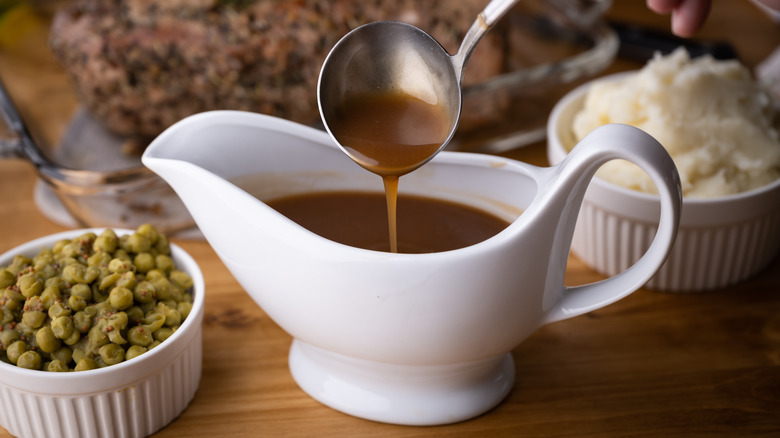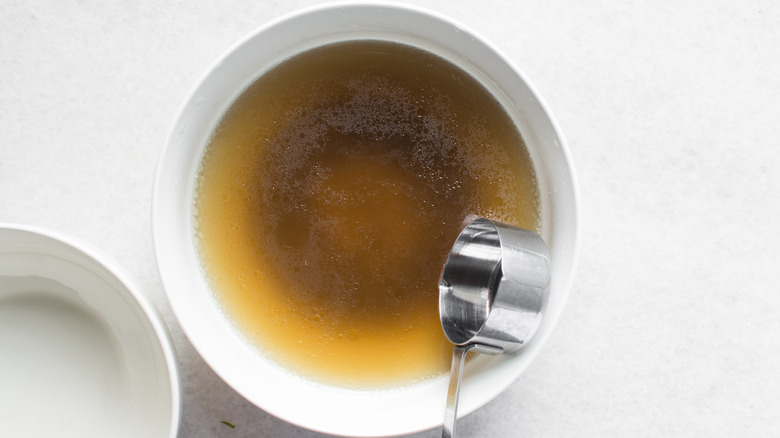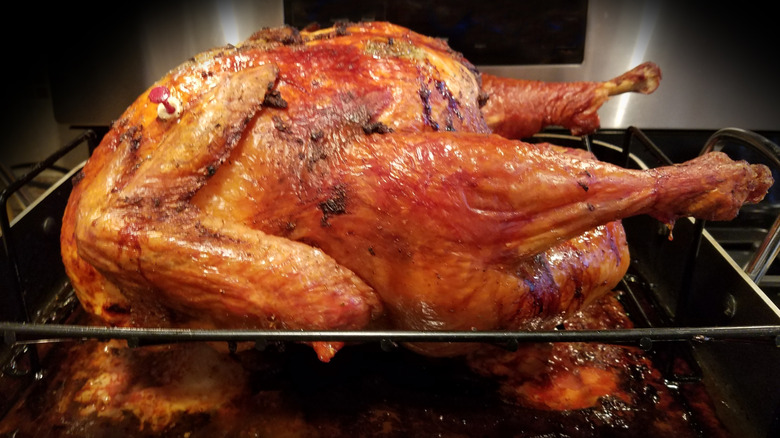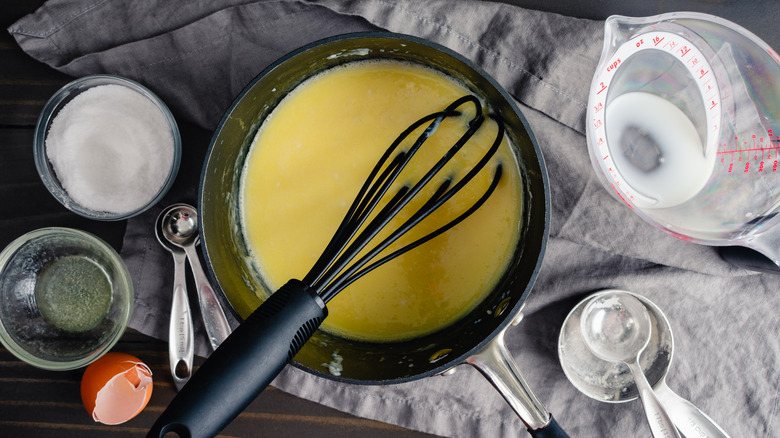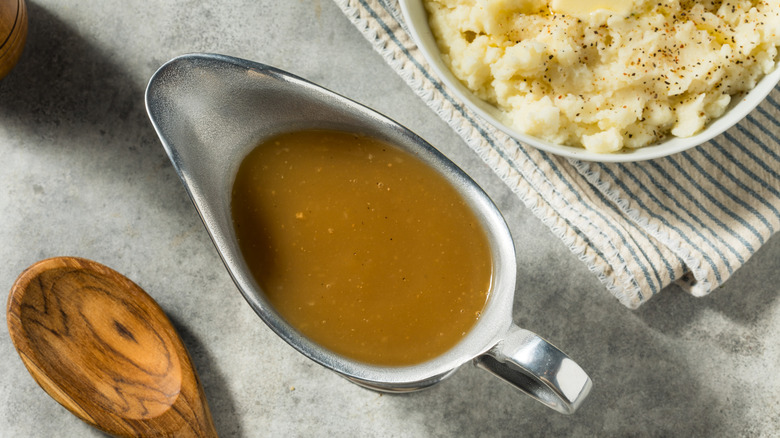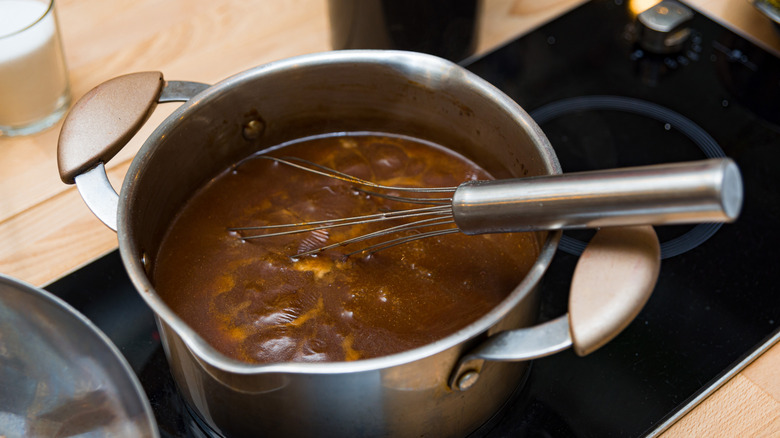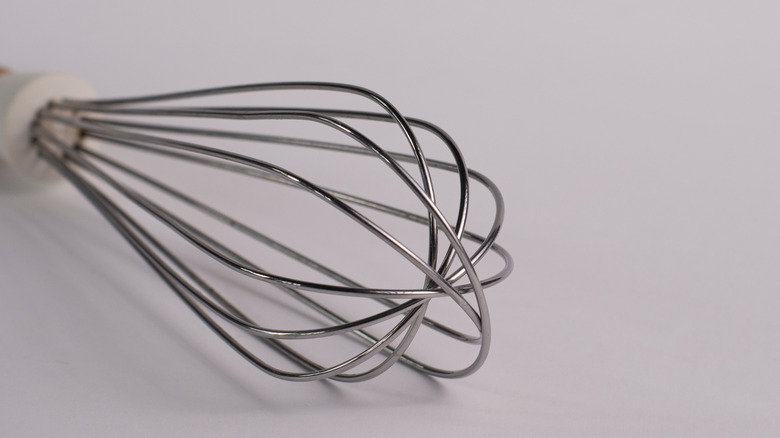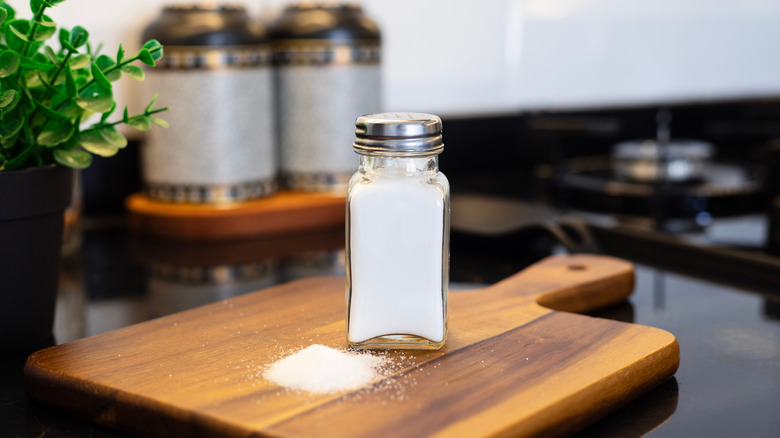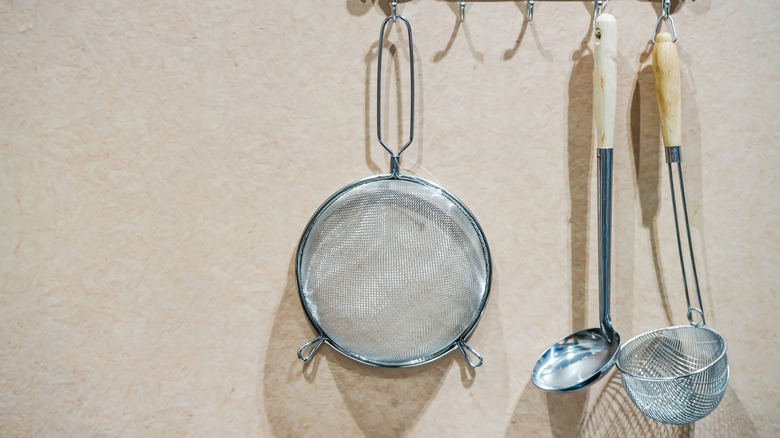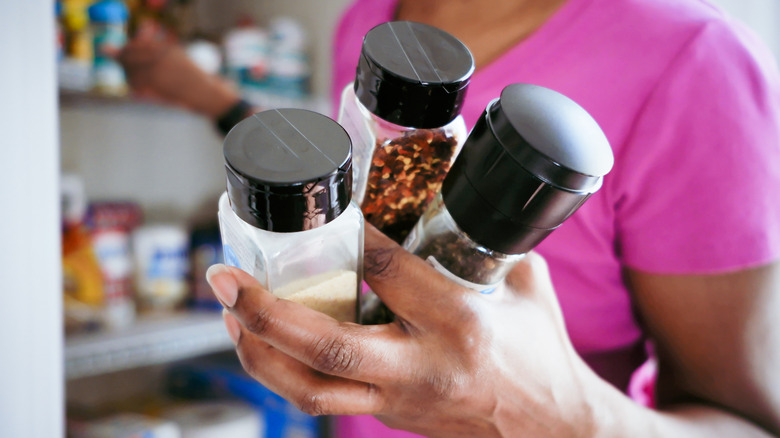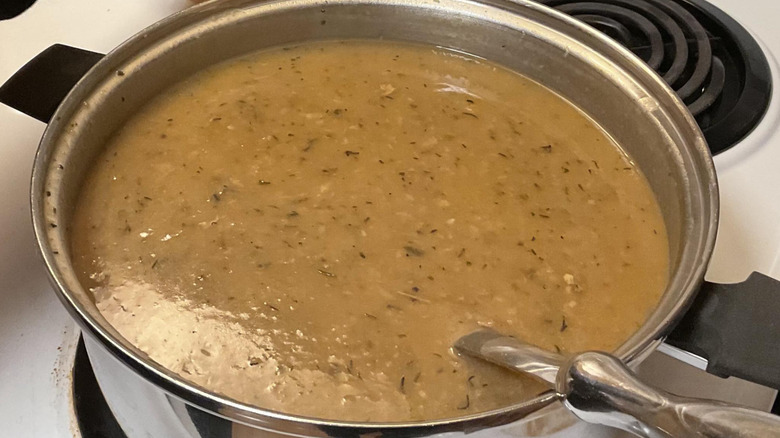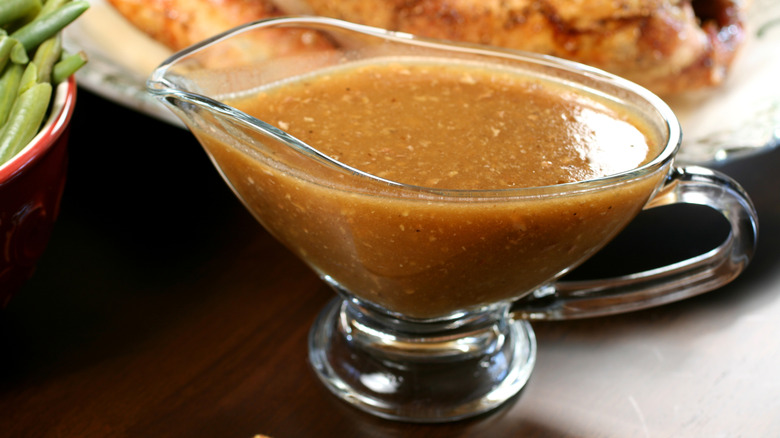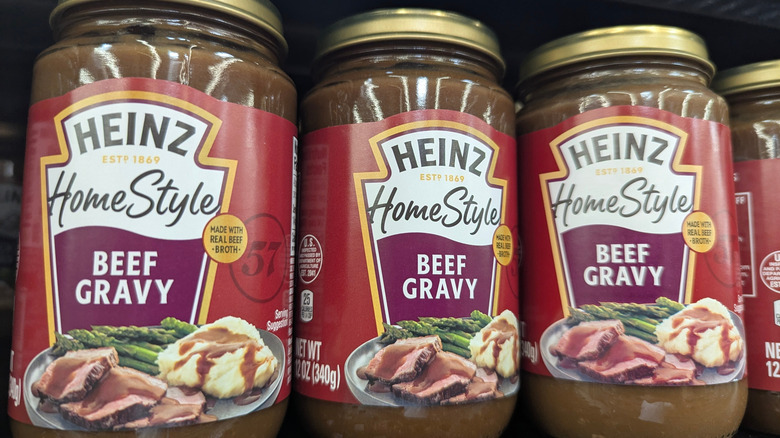12 Mistakes That Are Ruining Your Homemade Gravy
Gravy is a sauce made from the juices and scraps left over after cooking meat. Aside from pan drippings, gravy is also typically enriched with broth, seasoning, and aromatics and may be thickened with agents like roux. Since it utilizes what's already in the pan, gravy isn't just a great way of elevating meals but also combating food waste.
Often associated with home-cooked meals, gravy is served as an accompaniment to dishes such as roasted meats, mashed potatoes, and country-fried steak or chicken. Done well, it coats food that may otherwise be dry or bland, improving both its flavor and texture. Best of all, you can customize gravy to suit your specific taste preferences, infusing it with additional ingredients, including wine, herbs, and aromatics. But for a condiment, gravy can be surprisingly tricky to prepare, with even small mistakes possibly compromising its flavor and texture. These 12 simple errors may be keeping your gravy from becoming the centerpiece of your dining table.
Failing to factor in the stock or broth
Most gravy recipes — whether beef or poultry — use broth or stock as a standard base. Both add a savory depth to the sauce, with stock normally used for richer gravies, while broth is utilized for flavorful but lighter sauces. So, what's the difference between broth and stock, you may ask? Broth is made by simmering meat, vegetables, and seasonings, resulting in a flavorful but thinner base. Meanwhile, stock is made by simmering bones for longer periods of time to create a collagen-rich base for a thicker gravy texture.
If you don't have the time to make your own stock or broth at home, there are plenty of store-bought options fit for the job. For best results, select a stock or broth that's low in salt. You can always add more seasoning to the gravy later. If the commercial stock or broth tastes a little bland, you can also boost it with other ingredients. When adding the stock or broth to the roux (more on this later), do so slowly to ensure that the liquid blends with the flour before adding more. This will help prevent lumps. In addition, for lump-free gravy, cool the stock or broth to room temperature before whisking it into the hot roux.
Skipping pan drippings or making the gravy overly greasy
Regardless of whether you use stock or broth as the base of your gravy, adding pan drippings to the mix will give it a delicious umami flavor. The important thing to note is that pan drippings consist of grease and the browned bits at the bottom of the skillet, known as fond. What you are after are the browned bits and concentrated juices rather than the liquid fat that separates from the meat during the cooking process.
The best way to collect pan drippings is to deglaze the pan with a little stock or wine. This technique loosens the flavorful morsels stuck to the bottom of the pan, creating a tasty base for gravies. If you don't have pan drippings, one of the easiest ways to build a base for your gravy is by roasting chicken wings or turkey giblets to create fond. To make a rich, brown gravy, be sure to roast the drippings long enough in the pan to allow for browning and caramelization. Under-roasted drippings won't undergo the Maillard reaction — the process that gives meat its complex flavor and golden-brown crust.
Leaving the gravy too runny
One of the key appeals of gravy is its rich, velvety texture. An overly runny gravy fails to deliver this, tasting both lackluster and watered down. After all, gravy is meant to coat food, not make it soggy and unappealing. The easiest way to thicken gravy is by simmering it on the stove until all the excess liquid evaporates. It's important to know that while this method may be effective, it takes time and reduces the overall volume of the gravy. Cooking the gravy down can also make it overly salty, especially if you started out with an already salty broth or stock.
Alternatively, you can thicken gravy by combining it with a roux. To make a roux, melt butter or use the fat skimmed from the top of the drippings and mix it with flour until the roux reaches the consistency of a smooth paste and turns light brown. Never thicken gravy by mixing the flour directly with hot broth or stock, as this will make it lumpy. Aside from roux, another effective way to thicken gravy is with a slurry, which is a mixture of cornstarch or flour and water or broth.
Making the gravy overly thick
Gravy can become overly thick for a number of reasons. Insufficient broth, stock, or pan drippings can leave the sauce too dense and heavy. Simmering the gravy for too long can have the same effect. Similarly, adding too much thickener — such as a roux or a slurry — can leave the condiment with a paste-like, gloopy consistency. Finally, gravy often thickens as it cools, which means that a perfectly pourable gravy can turn gummy if it sits too long on the dining table.
Luckily, fixing an overly thick gravy is relatively easy. One of the best ways to thin out the sauce is by mixing it with broth or stock. Remember to add the liquid a little at a time, as adding too much at once can make the gravy too watery. It's best not to use water for this, since it doesn't have the umami richness of stock or broth, and can dilute the gravy's flavor. Once the gravy is the right consistency, we recommend conducting a taste test to check whether you need to adjust the seasoning.
Failing to simmer the gravy long enough or not whisking it properly
Unlike au jus, which has a light, broth-like consistency that's perfect for French dip sandwiches, gravy is better suited for heavier dishes such as roast turkey or meatloaf. Simmering gravy not only reduces it so it can coat food, but also allows its flavors to meld for a richer and more delicious final result. In contrast, gravy that hasn't been simmered long enough may taste flat or unfinished or have a chalky flavor of raw flour left over from the roux or slurry, which can ruin a well-prepared meal.
From the moment it hits the pan, gravy needs to be stirred — or rather, whisked — frequently. This is the only way to ensure that it doesn't turn out lumpy or gritty in texture, as the continuous movement will help to break down any clumps. It also stops the sauce from sticking to the bottom of the pan, where it could get scorched or burned, making the gravy taste bitter. Even after all the ingredients have been combined, the gravy still needs to be stirred as it simmers and reduces to maintain a smooth texture.
Using the wrong tool for the job
While you can probably get away with using a wooden spoon — or even a fork — to stir your gravy, it's not the best way to achieve a velvety smooth, lump-free sauce. A whisk is a much better tool for the job. Designed with multiple wire loops, a whisk is perfect for breaking up any lumps or flour pockets in the gravy, leaving it with a more even texture.
It's important to understand that not all whisks are built equal and that some are better than others when it comes to making gravy. For instance, flat or spiral whisks are strong choices for making gravy and sauces. They are also ideal for loosening the browned bits, or fond, from the bottom of the pot. Meanwhile, conical whisks are also a reliable option, as they feature tapered ends designed to reach the edges of the pan.
Luckily, if you already own a balloon or French whisk — which is essentially just a narrower balloon whisk — you can still use it to make a decent gravy, even if it may not be the ideal utensil for the job. While its rounded shape may not reach the corners of the pan, you can easily use a rubber spatula to periodically scrape the edges before returning to whisking the mixture.
Oversalting the gravy
Too much salt in a gravy can easily overpower the entire dish, masking the complex flavors from the meat, stock, and seasoning. Since gravy can become saltier as it simmers and reduces, it's best to season it only once it has achieved its final consistency. This way, you can be sure that you are neither oversalting nor undersalting it, leaving the flavors balanced. When cooking with a store-bought stock or broth, you may also want to pick one with a low sodium content.
If you have oversalted your gravy, there is no need to despair. It can still be salvaged by balancing the excess salt with a little broth or water, adding it gradually into the mix while stirring. If the condiment becomes overly thin, you can always thicken it again with a small amount of roux or slurry. Alternatively, make a second batch of gravy — this time completely unsalted — and combine it with the oversalted version.
An entire range of ingredients can be added to gravy to balance its flavors. Although they may not totally eliminate the saltiness, they may be your best option if you are short on time. These include a splash of acid, such as lemon juice or vinegar, a little sugar or honey, or a dash of dairy, such as cream, milk, yogurt, or sour cream.
Not smoothing out lumpy gravy
Poorly mixed gravy can ruin a perfectly decent dish. Flour clumps and a gloopy texture don't just look unappetizing, but can also create an unpleasant mouthfeel and detract from the flavors of your meal. There are many reasons why your gravy may turn out lumpy, one being using a spoon instead of a whisk for stirring. Another is thickening the condiment with flour or cornstarch rather than taking the time to make a roux or a slurry.
The good news is that you="" can="" still="" fix="" lumpy="" gravy"="">you can still fix lumpy gravy at the last minute. Perhaps the simplest way of doing so is by taking the condiment for a spin in a blender. Use an immersion blender to get rid of lumps directly in the pan, or transfer the gravy to a traditional blender or food processor. If you don't own a blender, there are other ways to salvage the sauce. Although it may not make the gravy completely smooth, vigorous whisking can go a long way to breaking down most of the lumps. An easier — and much less physically demanding — way of smoothing out gravy is to strain it through a fine-mesh sieve. For best results, use a spatula or a spoon to push the liquid through the strainer.
Failing to boost the flavor of the gravy with additional ingredients
Gravy brings all parts of a meal together, bringing together meals with various components – such as pot roast and mashed potatoes or roasted turkey with stuffing — for one harmonious culinary experience. Conversely, a gravy that lacks proper seasoning or complexity is unlikely to enhance the flavor of the other food on the plate. Instead, it may make the entire meal taste bland and unbalanced, no matter how much time and effort you put into its preparation.
Don't get us wrong — gravy made from stock and pan drippings already carries plenty of umami. However, a few extra layers of flavor can turn gravy from passable to extraordinary. Fortunately, there are plenty of flavor-packed ingredients that can elevate a basic gravy to the next level without overpowering the entire meal.
Aside from your basic salt and pepper, it pays to start a gravy with a base of herbs, such as thyme, sage, and rosemary, as well as aromatics, including garlic, shallots, and onion. All of these will go a long way toward giving the gravy a deep, layered flavor profile, making it taste richer and more satisfying. There are also plenty of other tricks that can intensify the condiment's taste profile, such as amping up the gravy with a spoonful of bouillon, a dash of soy sauce, or a splash of wine.
Failing to reheat leftover gravy properly
Gravy should be served hot while it's silky and smooth. Once it cools, the condiment tends to thicken and can even develop an unappetizing top layer. This is why any leftover gravy needs to be brought to the right temperature before it's served again. While it may be tempting to pop the sauce in the microwave, the intense heat and lack of frequent stirring can easily leave it overcooked or even burned. If you absolutely have to reheat your gravy in the microwave, mix it with ½ cup of stock for each quart of gravy. Microwave the sauce in 45-second intervals, stirring each time to ensure even heating.
The best way to preserve the flavor and consistency of leftover gravy is by reheating it on the stovetop in a saucepan. Using a skillet isn't recommended, as its wider surface area makes it easier to accidentally burn the gravy. To reheat the condiment, boil ½ cup of stock, turn off the heat, and whisk in ½ quart of gravy. Once the gravy is smooth, return the pan to low heat and whisk in the rest of the sauce, stirring continuously. The gravy is ready to serve once it reaches 165 degrees Fahrenheit.
Letting the gravy sit at room temperature or not storing it properly
Improper storage doesn't just risk the gravy's flavor but can also make it unsafe to eat. For instance, gravy should never be left out on your kitchen counter for longer than two hours. If the temperature is higher than 90 degrees Fahrenheit, the recommended safe period for leaving gravy out reduces to just one hour. The longer the gravy remains outside the refrigerator, the greater the risk of harmful bacteria multiplying in the food. The signs of gravy spoilage include a bad smell, discoloration, a slimy texture, or mold. If in doubt, it's best to trust your instincts and discard the condiment.
Proper storage is also important to ensure that the gravy maintains its flavor and texture and remains safe to eat. Gravy should always be stored in an airtight container or a jar separately from other foods to stop it from absorbing their flavors and odors. You can store your gravy in the refrigerator for up to four days. If necessary, you can also freeze it for up to six months.
Overlooking store-bought gravy as a backup option
Sometimes, you just don't have the time or energy to cook gravy from scratch. While there is no substitute for homemade gravy, there are some store-bought options that come a close second. Not only are they available in a range of flavors — including chicken, beef, or turkey — but store-bought gravy also features a consistent flavor and texture, which isn't always a given in homemade gravy. They also have a relatively long shelf life. That said, once mixed with poultry or meat, commercial gravy should be treated just like its homemade counterpart, which means that it shouldn't be stored in the refrigerator longer than four days.
Whatever gravy you choose at your local grocery store, there are plenty of ways to make it taste homemade. One of the best options is to enrich store-bought gravy with the pan drippings left over after roasting your meat. Alternatively, start by warming the gravy up in a saucepan before stirring in finely chopped fresh herbs such as thyme, parsley, or sage. In addition, you can easily boost the gravy's flavor by infusing it with a few drops of soy sauce or a pinch of seasonings and spices, such as garlic powder, cayenne, or onion powder.
